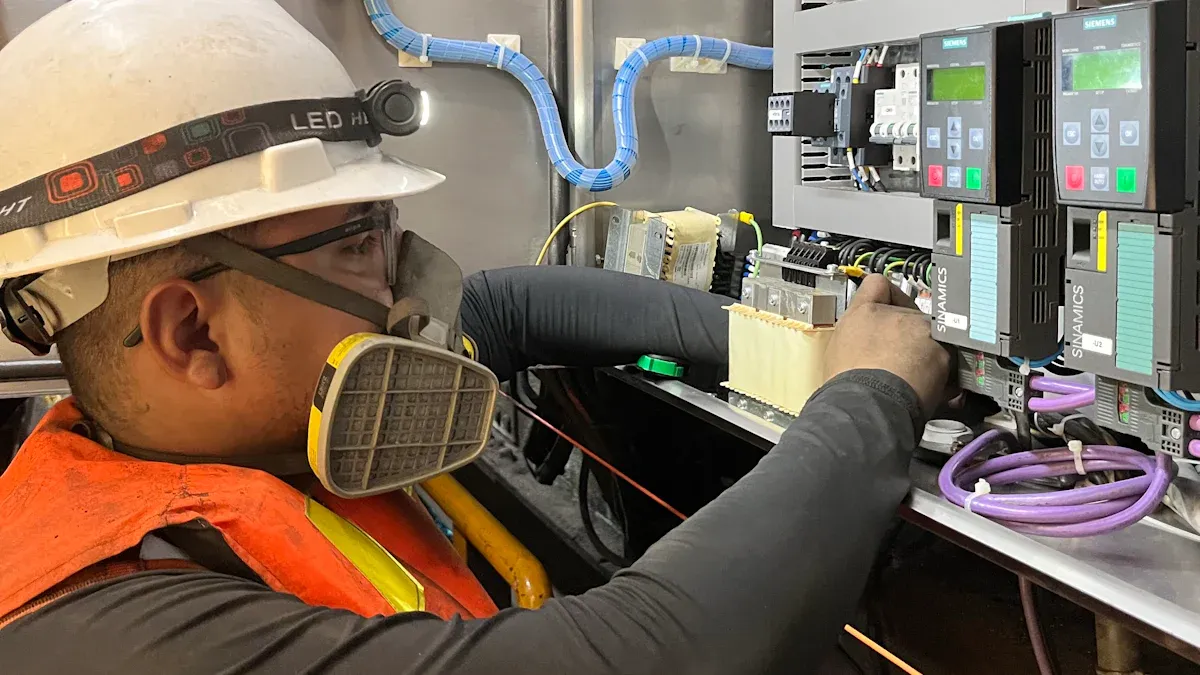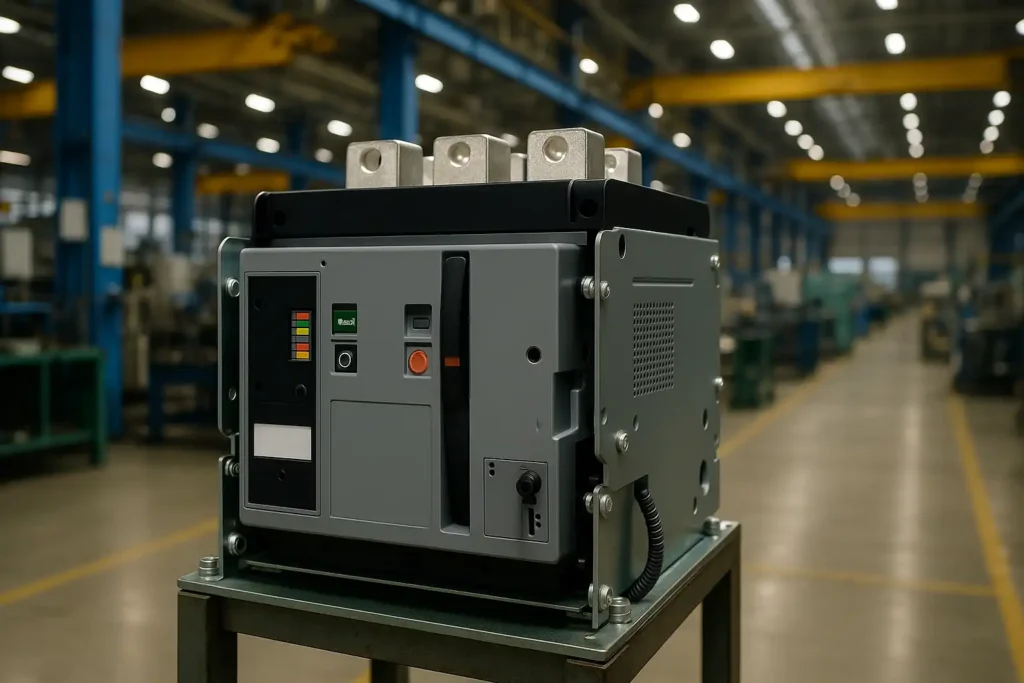The application of air circuit breaker is essential in power systems within factories and large buildings. These breakers are also commonly found in low-voltage switchgear. Their primary role is to protect electrical circuits from hazards such as overloads, short circuits, and ground faults. Engineers rely on the application of air circuit breaker technology to address common issues like worn-out contacts, loose connections, broken trip mechanisms, and insulation problems caused by dust or water. Utilizing the application of air circuit breaker ensures that facilities remain safe, reliable, and efficient in managing their electrical systems.
Key Takeaways
- Air circuit breakers keep electrical systems safe. They stop power fast during overloads, short circuits, or faults. This helps protect people and equipment from harm.
- They work in low-voltage systems up to 1,000 volts. They also work in medium-voltage systems up to 36,000 volts. You can find them in factories, buildings, and power stations.
- These breakers protect important equipment like motors, transformers, and generators. They handle large currents and stop damage from happening.
- Air circuit breakers use air to cool and stop electric arcs. This lowers fire risks and makes repairs easier.
- Testing and taking care of air circuit breakers is important. It stops sudden failures and keeps the power system working well.
Application of Air Circuit Breaker in Power Distribution

Low-Voltage Systems
Air circuit breakers help protect electrical circuits in low-voltage systems. These systems work at voltages up to 1,000 volts. The application of air circuit breaker technology stops damage from overloads, short circuits, and ground faults.
Air circuit breakers in these systems can handle many current levels. Molded case breakers work with currents from 100 amps to 2,000 amps. Bigger air circuit breakers in factories and large buildings can reach 4,000 amps. Some models can even go up to 6,300 amps. These breakers can stop up to 150,000 amps, so they are good for tough jobs.
Note: Low-voltage air circuit breakers can work in hard places. They can handle high heat, dust, and wet areas. You will find them in main power boards, sub-boards, and final boxes.
Places that use the application of air circuit breaker include:
- Data centers
- Manufacturing plants
- Airports
- Railway stations
- Commercial buildings
Here is a table with common ratings for air circuit breakers in low-voltage systems:
| Type of Air Circuit Breaker | Typical Current Rating (A) | Typical Voltage Rating (V) |
|---|---|---|
| Low-Voltage ACB | 100 to 6,300 | Up to 1,000 |
Air circuit breakers have many technical benefits in low-voltage systems:
- They stop high fault currents fast.
- You can change settings to fit your needs.
- Open design makes fixing them easy.
- Air puts out arcs, so there is less fire risk.
The application of air circuit breaker in low-voltage systems gives good protection and easy care. These breakers also let you control and check power, which keeps power safe and working well.
Medium-Voltage Systems
Medium-voltage systems use air circuit breakers for circuits from 1,000 volts to 36,000 volts. The application of air circuit breaker is common in factories, city substations, and smart city projects. These breakers connect high-voltage lines to low-voltage users.
Medium-voltage air circuit breakers are found in many important places:
- Distribution substations
- Airports
- Data centers
- Nuclear power plants
- Industrial factories
- Power generation stations
- Urban infrastructure
This table shows voltage groups for air circuit breakers:
| Voltage Category | Voltage Range / Levels (kV) | Notes |
|---|---|---|
| Low Voltage | Up to 1 kV (AC) or 1.5 kV (DC) | Typical low voltage definition |
| Medium Voltage | 1 kV to 69 kV (commonly) | Standard system voltages: 3, 6, 10, 20, 35, 66 kV; Switchgear voltages: 3.6, 7.2, 12, 24, 40.5, 72.5 kV |
| High Voltage | 110 kV and above | Typical high voltage definition |
Medium-voltage air circuit breakers give safe and low-cost protection. They use air to put out arcs, so they are safe inside buildings. These breakers last a long time and work well in rough places. The application of air circuit breaker in medium-voltage systems helps keep big buildings and factories safe.
Tip: Medium-voltage air circuit breakers cost less at first and last a long time. They are simple to fix and can be used in many power systems.
The application of air circuit breaker in both low-voltage and medium-voltage systems is very important in today’s power systems. These breakers help keep power safe and working in many places.
Industrial and Commercial Uses
Equipment Protection
Factories and big buildings use air circuit breakers to keep equipment safe. These breakers protect things like transformers, generators, and capacitors from electrical trouble. If there is a problem, like a short circuit or overload, the breaker acts fast. It stops the electricity right away. This helps stop fires, keeps equipment from breaking, and avoids power loss.
Air circuit breakers help with many common problems in industrial equipment. The table below shows how these breakers stop different issues:
| Failure Mode | Description / Explanation |
|---|---|
| Opened when it should not (False tripping) | Circuit breakers open when they are not supposed to. This causes power to stop for no reason. It is the most common problem. |
| Failed to open or close when required | Circuit breakers do not open or close when needed. This can hurt equipment. |
| Internal faults (dielectric breakdown) | Problems inside the breaker can make it stop working. You might not see anything wrong on the outside. |
| Contact erosion | The parts that touch wear out after being used a lot. This makes the breaker work less well over time. |
| Control wiring or actuator issues | Wires or moving parts can break. This stops the breaker from working right. |
The application of air circuit breaker lowers these risks. Engineers use special designs, checkups, and repairs to make sure breakers work. If a breaker does not trip when it should, backup systems fix the problem fast. This keeps the rest of the system safe and working.
Tip: Checking and testing air circuit breakers often can stop surprise problems and keep equipment working well.
Motor Starting
Big motors in factories need strong protection when they start and run. Air circuit breakers are very important for this job. They can handle big currents that happen when motors start. These breakers also keep motors safe from overloads and short circuits.
Here is how air circuit breakers help with motor starting and safety:
- Air circuit breakers find problems in two main ways:
- Thermal tripping: A metal strip bends when it gets hot from too much current. This makes the breaker open if the motor uses too much power for too long.
- Magnetic tripping: A strong magnet forms very fast during a short circuit. This trips the breaker in a split second and stops the current.
- When the breaker trips, it breaks the electric arc between the contacts. It uses air and special parts to cool and split the arc. This makes it safe to stop the current.
- Air circuit breakers can be set to match each motor’s needs. This helps protect motors of all sizes and types.
Air circuit breakers for motor starting usually work with 800 amps to 10,000 amps. You will find these breakers in motor control centers and big factories. They are good at handling big currents and keeping heavy machines safe.
Note: The application of air circuit breaker in motor starting makes sure motors run safely and do not get hurt by electrical problems.
Testing and Special Applications
Power Product Testing
Engineers use air circuit breakers in test labs. These labs check new electrical products and systems. Air circuit breakers help keep tests safe. They can handle big currents and sudden problems during tests. This makes them good for short-term setups and new product work.
Labs pick ACBs because they are simple to reset and fix. Workers can look at and repair them fast after tests. The open design lets workers find problems quickly. This saves labs both time and money.
Temporary places, like building sites or events, also use air circuit breakers. These places need strong protection for a short time. ACBs give good safety and are easy to move or swap out.
Tip: In test labs, workers should keep things clean and dry. They should check cords and gear often to stop sparks or problems.
High-Voltage Line Protection
Some high-voltage places need air circuit breakers for line safety. These places are substations and power plants. Air in ACBs helps stop fires and accidents. This matters where flammable things cannot be near.
Workers follow strict safety rules in these places:
- Keep flammable liquids away from electric gear.
- Keep work areas clean and dry.
- Check equipment for damage often.
- Use only grounded tools.
- Label panels and keep 3 feet of space.
- Guard live parts and let only trained staff near.
- Use ACBs to stop too much current and overheating.
- Keep things tidy to lower fire and shock risks.
Air circuit breakers are very important in these places. They give strong protection and help keep people and gear safe. Using them in high-voltage and special jobs shows how useful they are in today’s power systems.
Air circuit breakers are used in many parts of power distribution. They keep equipment safe and help motors start safely. They also help keep the power grid steady. Some main benefits are:
- They find and stop problems very quickly.
- They put out electric arcs to keep things safe.
- They can watch systems and give live data.
- They cost less to take care of and are better for the environment.
New features like smart sensors and remote control make air circuit breakers work even better. As power systems get smarter and harder, these breakers are still needed for safe and good operation.
Choose ONESTOP air circuit breaker: With over 20 years of manufacturing experience, international certification assurance, and excellent quality, we help you comprehensively improve circuit safety protection.
FAQ
What is the main job of an air circuit breaker?
An air circuit breaker keeps electrical circuits safe. It stops electricity if there is a problem. Problems can be overloads or short circuits. This helps protect people and equipment.
Where do engineers usually install air circuit breakers?
Engineers put air circuit breakers in many places. They use them in factories and commercial buildings. Power distribution panels also have these breakers. These places need strong protection for their electrical systems.
How does an air circuit breaker put out an electric arc?
The breaker uses air to cool the electric arc. Air splits the arc and stops electricity from flowing. This keeps fires and damage from happening.
Can air circuit breakers be used for both low and medium voltage?
Yes, air circuit breakers work in both types of systems. They protect low-voltage systems up to 1,000 volts. They also protect medium-voltage systems up to 36,000 volts. Many places use them for reliable safety.
What are some benefits of using air circuit breakers?
Air circuit breakers are simple to take care of and reset fast. They give strong protection for electrical systems. You can check and adjust them easily. This makes them a good choice for many power systems.
The following information may be of interest to you
Application and advantages of air circuit breakers
Comprehensive guide for wiring methods of air circuit breakers
How to Install an Air Circuit Breaker in Simple Steps




